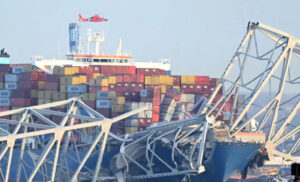
Shipping access throughout the Mid-Atlantic is expected to be severely disrupted following a container ship accident that collapsed the Francis Scott Key Bridge, paralyzing a large swath of the largest inland port on the East Coast.
The Singapore-flagged Dali—chartered by Maersk and moving outbound from the Port of Baltimore—struck the Key Bridge around 1:30 a.m. on March 26. The bridge spans the Patapsco River, a key waterway that serves the Port of Baltimore as a hub for East Coast shipping. Baltimore is the most inland port on the East Coast and is connected to the I-95 highway network. With no commercial vessels sailing in and out of port anytime soon, officials say this could spark supply chain snarls in the Mid-Atlantic and Northeast.
Impacts on flooring
Flooring executives say the bridge collapse, while devastating to overall commerce in the region, will have a relatively minimal impact on flooring, save for those flooring entities in the region that import into the Port of Baltimore. “And even with that, it’s just a matter of redirecting shipments to ports in Newark (N.J.), Norfolk (Va.) or other port entries along the East Coast,” Jeff Striegel, president of Owings Mills, Md.-based distributor Elias Wilf, told FCNews. “Thankfully there will be no impact on Wilf other than the container ships due into port this week and in the weeks ahead as this blocks the entry into all Baltimore ports.”
Striegel then added, “The shipping dilemma is the gift that just keeps on giving.”
Even before the Port of Baltimore disruption ocean freight services from the Far East to the U.S. East Coast have already been impacted by drought in the Panama Canal and recent conflict in the Red Sea, which saw freight rates increase by 150%.
Emily Stausbøll, an analyst at Oslo, Norway-based shipping-analytics company Xeneta, warned that the bridge collapse threatens to hamper global trade flows that are already under strain. “The question is how quickly ocean freight carriers can put diversions in place, particularly for vessels already en route to Baltimore or containers at the port waiting to be exported.”
The Port of Baltimore handled over 52 million tons of international cargo valued at more than $80 billion last year, ranking it as the ninth-busiest port in the United States, according to the Maryland government’s website. Its data show that the port handled 847,158 autos and light trucks in 2023, the most of any U.S. port. The port also handles farm and construction machinery, sugar, gypsum and coal.
